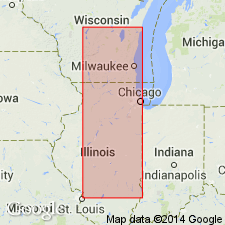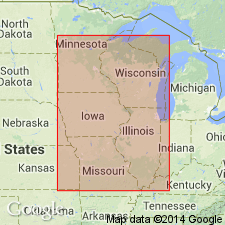
- Usage in publication:
-
- Wisconsin stage of glaciation*
- Wisconsin drift*
- Modifications:
-
- Overview
Summary:
Wisconsin stage of glaciation, also Wisconsin drift (Pleistocene). Wisconsin stage is name applied to last stage of glaciation, which has usually been divided into two substages, called early Wisconsin and late Wisconsin. Three substages (early, middle, and late Wisconsin) are, however, now recognized by Leverett (Moraines and shore lines of Lake Superior Region, USGS Prof. Paper 154A, 1929). The name was proposed by T.C. Chamberlin (Great ice age, by James Gelkie, 3d ed., p. 754-775, 1894) in the form East Wisconsin stage of glaciation for the time, and East Wisconsin formation for the deposits, because of their development in eastern Wisconsin. In 1895 (Jour. Geol., v. 3, p. 270-277) Chamberlin, upon the suggestion of Upham, shortened the name to Wisconsin. In 1931 (Jour. Geol., v. 39, p. 51-53) M.M. Leighton proposed to "reclassify the Iowan and Wisconsin drifts" by including in the Wisconsin the Peorian loess and underlying Iowan drift. He also introduced Hudsonian substage for the late Wisconsin drift, Quebecan substage for the early and middle Wisconsin drift, and applied the new name Manitoban substage to the Iowan drift. (See under †Manitoban substage.) In 1933, however (Sci., v. 77, p. 168), he withdrew his proposed names Hudsonian, Quebecan, and Manitoban, and proposed the following subdivisions of his Wisconsin (or fourth) glacial "age": Mankato (late Wisconsin), Cary (middle Wisconsin), Tazewell (early Wisconsin), and Iowan (oldest Wisconsin). Frank Leverett, 1933 (Sci., v. 77, p. 560), objected to introduction of Mankato, Cary, and Tazewell. (See under Mankato substage.) In 1931 (GSA Bull., v. 42, pt. 1, p. 449+) G.F. Kay introduced Eldoran epoch to include Wisconsin, Peorian, and Iowan. In 1933 (GSA Bull., v. 44, p. 669-673, August 31) Kay and Leighton proposed the following classification for Mississippi Valley:
Pleistocene of Glacial period (system):
Eldoran epoch (series) [redefined to include Recent.]:
Recent age (stage).
Wisconsin age (stage):
Mankato substage (late Wisconsin).
Cary substage (middle Wisconsin).
Tazewell substage (early Wisconsin).
Iowan substage.
Centralian epoch (series):
Sangamon age (stage).
Illinoian age (stage).
Ottumwan epoch (series):
Yarmouth age (stage).
Kansan age (stage).
Grandian epoch (series).
Aftonian age (stage).
Nebraskan age (stage).
Regarding Peorian they stated: The name Peorian will continue to be used in Iowa for the widespread loess which lies on the Iowan drift and around its border and beneath the Mankato (late Wisconsin) drift; and in Illinois for the widespread loess which lies above the late Sangamon loess outside of Tazewell drift. Within the border of Tazewell drift the loess which immediately underlies it may be called Iowan, as originally proposed, and the loess which overlies it the Tazewell loess. These two loesses are indistinguishable outside of the Tazewell drift border and compose the Peorian loess.
Source: US geologic names lexicon (USGS Bull. 896, 2356-2357).

- Usage in publication:
-
- Wisconsinan Stage*
- Modifications:
-
- Reference
- AAPG geologic province:
-
- Wisconsin arch
Summary:
Defined as time-stratigraphic unit for use in WI and IL, within Wisconsin arch and Illinois basin. Includes all deposits from unconformable contact of Roxana Silt on A-horizon of Sangamon soil to top of Cochrane till and its contact with overlying post-Cochrane deposits in James Bay Lowland, Ontario, CN. Includes in ascending order, Altonian, Farmdalian, Woodfordian, Twocreekan, and Valderan Substages. As most exposures within area of Wisconsinan glacial deposits contain only a small part of sequence, type area must include sections occurring over several hundred miles from central IL to Door Peninsula, WI. In reference sections at Pleasant Grove School in SE1/4 sec 20, T3N, R8W, Madison Co, IL and at Cottonwood School in sec 11, T18N, R11W, Cass Co, IL, only Altonian and Woodfordian Substages are present; reference section at Wedron, in SE1/4 SW1/4 sec 9, T34N, R4E, LaSalle Co, IL, only Farmdalian and Woodfordian Substages are present. Radiocarbon dates range from 28,000 yrs B.P. for top of Altonian (no date on base of Altonian, though probably is about 75,000 yrs) to between 5000-10,000 yrs B.P. Pleistocene age.
Source: GNU records (USGS DDS-6; Denver GNULEX).

- Usage in publication:
-
- Wisconsin time
- Modifications:
-
- Overview
Summary:
Shown as an informal time term ranging from 122,000 to 10,000 yrs and as of late Pleistocene age. Divided into "Eowisconsin" (122,000-79,000 yrs), early Wisconsin (79,000-65,000 yrs), middle Wisconsin (65,000-35,000 yrs), late Wisconsin (35,000-10,000 yrs).
Source: GNU records (USGS DDS-6; Reston GNULEX).
For more information, please contact Nancy Stamm, Geologic Names Committee Secretary.
Asterisk (*) indicates published by U.S. Geological Survey authors.
"No current usage" (†) implies that a name has been abandoned or has fallen into disuse. Former usage and, if known, replacement name given in parentheses ( ).
Slash (/) indicates name conflicts with nomenclatural guidelines (CSN, 1933; ACSN, 1961, 1970; NACSN, 1983, 2005, 2021). May be explained within brackets ([ ]).

